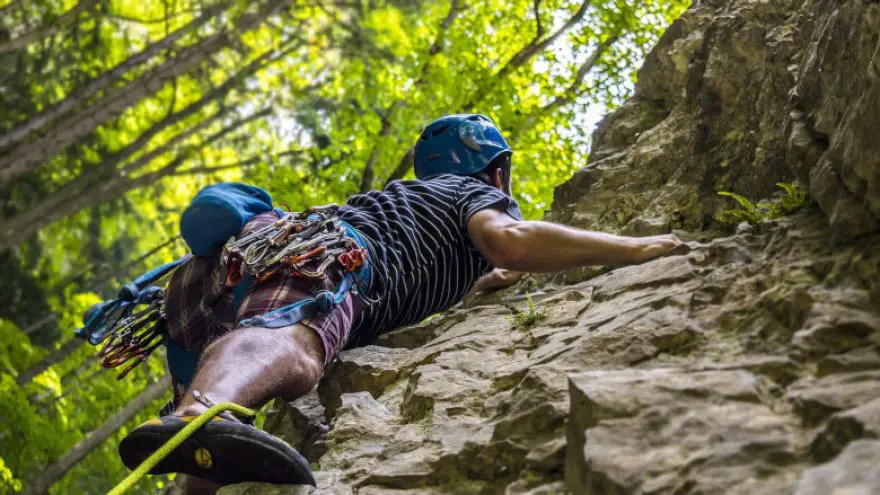When to Retire Climbing Gear
 When to Retire Climbing Gear
gearweare.net
When to Retire Climbing Gear
gearweare.net
Spending time in nature can be a truly joyful experience – there is a reason so many are dawn to outdoor recreation. However, being exposed to the elements can also be quite dangerous. One of the best ways to keep yourself safe while adventuring is to keep your gear clean and in good shape and to replace it when it is beyond repair.
The timely replacement of gear is especially important for rock climbing, an outdoor activity that falls within the category of “extreme sports.” Climbers rely on their climbing equipment to stop them from plummeting to the ground when they fail to pull the crux, they weight the rope at anchors, and for everything else that isn’t upward movement via their own hands and feet.
The gear involved in climbing works as a system. Any part of that system failure could cause the climber to fall. It is therefore critical that compromised gear should be retired and replaced. Below you will find directions on how to check climbing gear for damage, what damage looks like, and any other pertinent information for staying safe while taking whips.
Table of Contents
 Damage That Affects All Gear
Damage That Affects All Gear
UV rays from the sun break down anything exposed to them for too long. Keep your climbing gear out of the sun when cragging, and in a cool, dry, and dark space when stored at home. When checking your soft goods gear, keep an eye out for discoloration, which is a sign of sun damage.
You also want to avoid getting any kind of chemical on your gear. Petrol, battery acid, and other similar nasty stuff will immediately decommission any gear that comes into contact with it. This is especially important to keep in mind if you store your climbing gear in the garage.
Rope
Ropes should be checked for damage constantly, as most trad and sport climbers use a rope system this is a single point of failure, meaning there is no backup if the rope breaks. It’s easy to check your rope at the beginning and end of a day of climbing. Before you climb run the entire length of your rope through your hands, stacking it neatly on top of itself. Do this again before wrapping your rope at the end of the day. This technique, called “flaking”, also help to keep a rope from twisting.
As you flake, feel for any flat or fuzzy sports, cuts, and stiff areas. Flat areas indicate that the core has become deformed and is compromised, and cuts that expose the core, called “core shots”, always mean the rope is ruined.
A stiff rope indicates that it has lost its elasticity. In this case, the rope will no longer stretch as much when waited, making hard catches likely. The higher forces generated on the system by a stiff rope can also cause the gear to fail, especially when using minimal and unideal trad placements or ice screws.
Ropes lose elastically with time, as well as with use, so even a rope that is never used should eventually be retired. The excepted guidelines for when to retire a rope are as follows:
- Used more than once a week – Within 1 year
- Used weekly (weekend warrior) – Between 1-3 years
- Used once a month – Between 4-5 years
- Used a few times a year – 7 years
- Never used – 10 years (This rule of ten years goes for all nylon products, including harnesses, quickdraws, and slings as well as ropes.)
Finally, a rope should be retired after it takes an especially large or dramatic fall, or is weighted by an especially heavy load.
 Harness
Harness
Make sure to give your harness a good look over every once and a while. Fraying or cuts to the webbing or fabric of your harnesses belt, leg loops, belay loop, and tie in loops indicate structural damage. The tie in loops are especially susceptible to damage and should be checked more regularly than the other areas. Also, make sure to check for damage to the buckles. Any of this disrepair means it’s time to get a new quality climbing harness.
A little bit of fuzz on a harness is ok as long as all the structural threads and fibers are still intact. However, harnesses that show no or minimal signs of damage should still be retired after 5-7 years of use.
Slings, Webbing, and Cord
The rules for when to retire these soft goods are almost the same as when to retire a harness. Look for any obvious damage such as holes, rips, burns, or frays, and immediately decommission if any of these problems are found.
The one difference is lifespan – an often used sling, webbing, or cord will last between 2-5 years.
Carabiners
If properly stored and minimally used, carabiners can last indefinitely. However, the rope running through a carabiner will eventually wear it down. If this happens, it is no good. Cracked or chipped carabiners should also be discarded. If a carabiner is dropped but shows no visible damage, it may be ok but it also may not be. Use your discretion – you know how far and hard the carabiner fell – and be smart.
The other thing to watch for with carabiners is the gate. If the gate stops shutting properly, try cleaning and oiling it. If that doesn’t return it to normal, the carabiner is no longer any good. This is important because when open, carabiners can only take a fraction of the shock force that they can when shut.
Belay Device
Belay devices can become worn where the rope runs in and out of them. It is possible for the wearer to create a sharp edge. Since, like ropes, the belay is non-redundant, it is very important to consistently check your belay device for any damage, and to retire it if it becomes at all suspect.
Helmet
If a helmet cracks or becomes deformed in any way, it should be replaced. After a large impact, even if the helmet has no visible damage, your helmet should also be replaced. Helmets that are in good shape still don’t last forever. Similar to nylon soft goods, an unscratched helmet has a shelf life of 10 years.











